Smarter Balanced Interim Comprehensive Assessments (ICAs)
The user interface for the Interim Comprehensive Assessments (ICAs) functions similarly to Interim Assessment Blocks (IABs) in many aspects.
ICA Results in Group View
The group view provides an aggregate and individual display of a selected assessment for an assigned group, a custom group, or a school. Refer to the View Student Assessment Results by School and Grade or the View Student Group Assessment Results for details.
Once a user selects an ICA to display in the group view, the Results panel for an ICA displays as shown below. The Results View table for ICA results can be toggled to show Overall or Claim level scores as available for the assessment chosen. Overall is the default selection.
The ICA Results panel contains many of the same elements as the IAB/IA Results panel. The ICA Results panel is shown below.
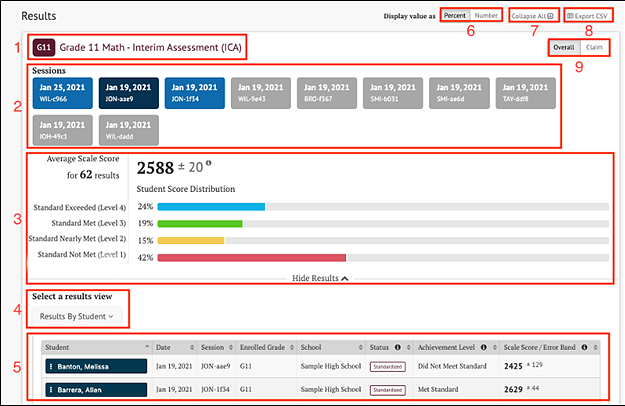
Figure 1. ICA Results page
Each ICA Results page displays the following information and elements:
- Name and grade of the assessment
- Testing session(s) from which results are displayed. These sessions appear once a test is completed (and scored). Please note that testing sessions appear here for interim assessments only.
- Group Aggregate panel displays aggregate data for the selected groups of students
- Select a results view drop-down menu offers the following options for display results:
- [Results By Student] (default view)
- [Results By Item]
- [Key/Distractor Analysis] (for selected-response items)
- [Writing Trait Scores] (for ELA only)
- Results View table
- Display value as field: Contains toggles allowing a user to change the display to show the student score distribution in percentages of students or numbers of students in each reporting category
- [Collapse All] button: Hides the Results by Student table for all the displayed assessments and toggles to an [Expand All] button, which displays the results again
- [Export CSV] button: Gives the option to download the results in CSV format
- [Overall/Claim] toggle: Toggles between results views of Overall and Claim scores
ICA Group Results
The ICAs report two performance scores: Overall and Claim. For Overall scores, the [Overall] toggle displays the Student Score Distribution with four achievement levels.
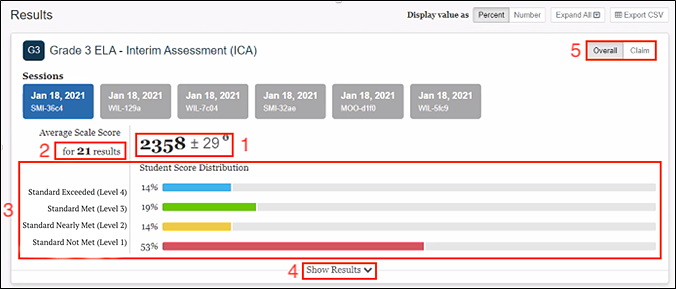
Figure 2. Overall Group Results for ICAs
The Group Aggregate panel for ICA Overall Scores displays the following information and elements:
- Average Scale Score: Average scale score for the selected group of students and an error band based on the Standard Error of the Mean
- Number of student test results from which the scores are calculated
- Student Score Distribution: Score distribution for the performance levels of the overall score
- [Show Results] button: Displays the Results View table for the displayed assessment and toggles to a [Hide Results] button that can hide the table
- [Overall/Claim] toggle: for Performance Scores Overall and Claim
- For Overall scores, the [Overall] toggle displays the Student Score Distribution with four achievement levels.
- For Claims, the [Claim] toggle displays the claims associated with the subject, each with three reporting categories.
For Claims, the [Claim] toggle displays four claims, each with three reporting categories.
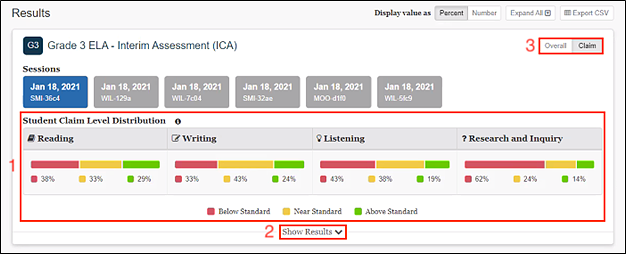
Figure 3. Claim Group Results for an ELA ICA
The Group Aggregate panel for ICA Claim Scores displays the following information and elements:
- Student Claim Level Distribution: Displays the claim level distributions for the selected group of students
- [Show Results] button: Displays the Results View table for the displayed assessment and toggles to a [Hide Results] button that can hide the table again.
- [Overall/Claim] toggle: Switches between the Performance Scores Overall and Claim
ICA Results By Student
The Results By Student table for ICA results can be toggled to show Overall or Claim scores. Overall is the default selection.
ICA Results By Student Overall Scores
When the [Overall] button is selected, the Results View includes the information elements for each student shown in figure 4.
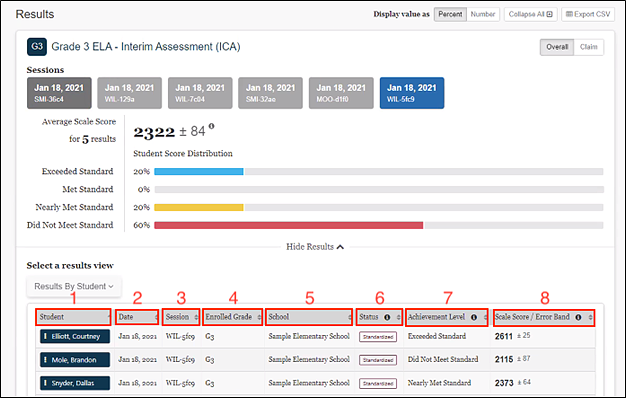
Figure 4. ICA Results By Student Overall Scores table
The Overall Score table includes the following information for each student:
- Student: Student’s full name and a Context Menu three dots icon [
 ] that provides access to additional student details (refer to the IAB Student Options section)
] that provides access to additional student details (refer to the IAB Student Options section) - Date: Date student completed the assessment
- Session: Testing session identifier
- Enrolled Grade: Student’s enrolled grade at the time of the assessment
- School: Student’s assigned school at the time of the assessment
- Status: The assessment status, which includes whether the assessment administration (Manner of Administration) was Standardized or Nonstandardized, or if the assessment was marked Partial or Complete (Completeness)
- Achievement Level: Student’s achievement level on the assessment: Did Not Meet Standard, Nearly Met Standard, Met Standard, or Exceeded Standard
- Scale Score/Error Band: Student’s scale score and score error band based on the SEM associated with that score
ICA Results By Student Claim Scores
When the [Claim] button is selected, the Results By Student view changes to show each student’s assessment results by Claim, as shown in figure 5. Return to the default view by selecting the [Overall] button.
The Student Claim Score Distribution table displays the number/percent of students scoring in each reporting category (Below Standard, Near Standard, or Above Standard) for each claim.
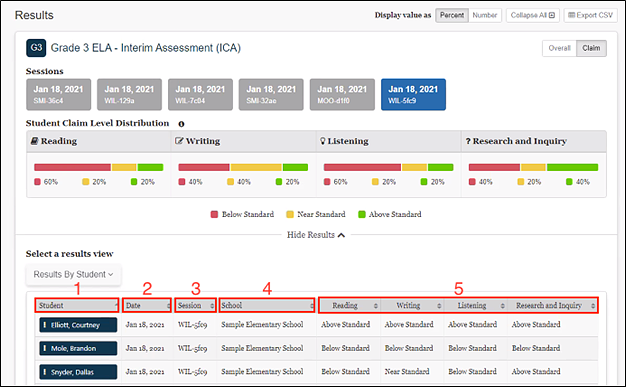
Figure 5. ICA Results By Student Claim Scores
Each student result in the Claim Scores view shows the following elements:
- Student: Student’s full name and Context Menu three dots icon [
 ] provides access to additional student details (refer to the IAB Student Options section)
] provides access to additional student details (refer to the IAB Student Options section) - Date: Date student completed the assessment
- Session: Testing session identifier
- School: Student’s assigned school at the time of the assessment
- Student performance noted as Above Standard, Near Standard, or Below Standard for each of the assessment claims
ICA Writing Trait Scores
Writing trait scores are available for ELA ICAs. A sample display is shown in figure 6:
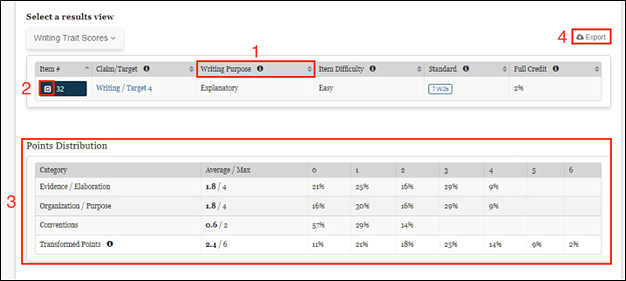
Figure 6. ICA Writing Traits Scores view
The Writing Trait Scores Item table appears similarly as in the Results By Item table, with the following differences:
- Writing Purpose: A new column displays the purpose of the writing tasks (Argumentative, Explanatory, Informational, Narrative, or Opinion).
- [Item drop-down arrow] icon: Selecting an item’s drop-down arrow icon [
 ]expands the row to allow viewing of the item and additional information about the item (refer to the IAB Results By Item Details section).
]expands the row to allow viewing of the item and additional information about the item (refer to the IAB Results By Item Details section). - Points Distribution table:
- Each row lists the category of writing performance, or writing trait (Evidence/Elaboration, Organization/Purpose, and Conventions), the group average and maximum points for that category, and the percentage/number of students who earned each number of points for that category.
- The final row is for the transformed points calculated from all categories (refer to the Interpretive Guide for an explanation of how transformed points are calculated for extended written response items).
- [Export] button: Exporting is available to export the report results (both the Results By Item table and the Points Distribution table combined) to a CSV file.
Writing Extended Response (WER) Condition Codes for ELA ICAs
Writing Extended Response (WER) Condition Codes are used for responses to full-write essay items that cannot be scored because of the nature of the student’s response. A detailed description of each available condition code is provided in table 1.
When a student response is assigned a condition code, it is equivalent to a score of zero, with the exception of the “off purpose” code. In most cases, when a full-write response receives a condition code, that code is assigned to all three dimensions of the response. However, beginning with the 2022–23 test administration, if the condition code for a response is “off purpose,” only the evidence/elaboration and organization/purpose dimensions are assigned “off purpose,” and the conventions dimension is still scored. This conventions item score is included in the total ELA score and the writing claim score. The rule for “off purpose” scoring of conventions is applied regardless of the genre of the writing prompt.
Writing Extended Response (WER) Condition Codes are available to use in the IAHSS (Interim Assessment Hand Scoring System) and should be used as applicable.
| Condition Code | Description |
|---|---|
| Blank (B) | Student did not enter a response. |
| Insufficient (I) |
Student has not provided a meaningful response; examples can include
For ELA full-writes, responses previously described and if the student’s original work is insufficient to determine whether the student is able to organize, cite evidence and elaborate, and use conventions as defined in the rubrics; or the response is too brief to determine whether it is on purpose or on topic. |
| Non-scorable Language (L) |
ELA: language other than English Mathematics: language other than English or Spanish |
| Off Topic (T) |
For ELA Full-Writes Only A writing sample will be judged as off-topic when the response is unrelated to the task or the sources or shows no evidence that the student has read the task or the sources (especially for informational/explanatory and opinion/argumentative). Off-topic responses are generally substantial responses. |
| Off Purpose (M) |
For ELA Full-Writes Only A writing sample will be judged as off-purpose when the student has clearly not written to the purpose designated in the task. An off-purpose response addresses the topic of the task but not the purpose of the task. Off-purpose responses are generally developed responses (essays, poems, etc.) clearly not written to the designated purpose. If the condition code for a response is “off purpose,” only the evidence/elaboration and organization/purpose dimensions are assigned “off purpose,” and the conventions dimension is still scored. |
Lexile and Quantile Measures
CERS contains Lexile measures and ranges for Smarter Balanced ELA summative assessments and ICAs, and contains Quantile measures and ranges for Smarter Balanced Math summative assessments and ICAs.
Lexile Measures for ICAs
Lexile Measures in Group View
The group view provides an individual display of Lexile measures and Lexile ranges for an assigned group, a custom group, or a school. Refer to the View Student Assessment Results by School and Grade section or the View Student Group Assessment Results section for details. Once a user selects an ELA ICA to display in the group view, the Results page displays as shown in figure 7.
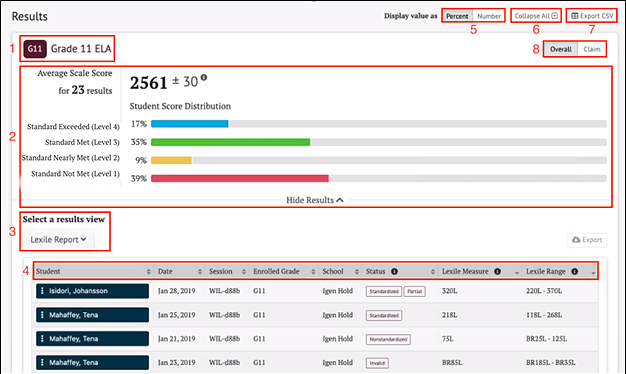
Figure 7. Lexile Report display
The Results page for a Smarter Balanced ICA displays the following information and elements:
- The name and grade of the assessment
- The Group Aggregate Panel displays aggregate data for the selected group of students
- The Select a results view drop-down menu offers the following options for display results:
- [Results by Student] (default view)
- [Results By Item]
- [Key/Distractor Analysis]
- [Writing Trait Scores] (for ELA only)
- [Lexile Report]
- The Results View table
- The Display value as field contains toggles allowing a user to change the display to show the student score distribution in percentages of students or numbers of students in each reporting category
- The [Collapse All] button, which hides the Results View table for all the displayed assessments and toggles to an [Expand All] button, which displays the results again
- The [Export CSV] button, which gives the option to download the results in CSV format
- Toggle buttons to switch between Performance Scores: [Overall] and [Claim]
- For Overall scores, the [Overall] toggle displays the Student Score Distribution with four achievement levels
- For Claims, the [Claim] toggle displays four claims with three reporting categories
Select a results view for the Lexile Report
Per figure 8 (below), when the Select a results view drop-down is selected, the Select a results view options appears:

Figure 8. Select a results view for the Lexile Report
The options for each student are:
- [Results by Student] (default view)
- [Results By Item]
- [Key/Distractor Analysis]
- [Writing Trait Scores] (for ELA only)
- [Lexile Report]
Lexile Measure and Lexile Range

Figure 9. Lexile Measure and Range view
- The Select a results view drop-down menu offers the following options for display results:
- [Results By Student]
- [Results By Item]
- [Key/Distractor Analysis]
- [Writing Trait Scores]
- [Lexile Report]
- Lexile Measure: A student’s Lexile measure represents the student’s ability to read independently on a scale from below 0L to above 1600L.
- Lexile Range. A student’s Lexile range is 50L above and 100L below the student’s Lexile measure.
Lexile Measures By Student
The Results By Student table includes the information elements for each student shown below.
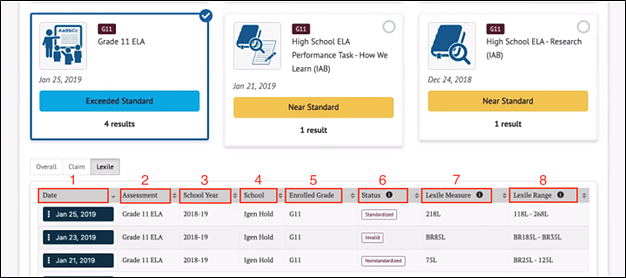
Figure 10. Lexile Measures By Student
The Overall Score table includes the following information for each student:
- Date: Date student completed the assessment
- Assessment: Name of Assessment
- School Year: School year for assessment
- School: Student’s assigned school at the time of the assessment
- Enrolled Grade: Student’s enrolled grade at the time of the assessment
- Status: For interim assessments, assessment status includes whether the assessment administration (Manner of Administration) was Standardized or Nonstandardized, or if the assessment was marked Partial or Complete (Completeness). For summative assessments, assessment status only includes whether the assessment administration (Manner of Administration) was Valid or Invalid. An empty field for a summative assessment indicates a valid assessment status.
- Lexile Measure: A student’s Lexile measure represents the student’s ability to read independently on a scale from below 0L to above 1600L.
- Lexile Range. A student’s Lexile range is 50L above and 100L below the student’s Lexile Measure.
Quantile Measures for ICAs
Quantile Measures in Group View
The group view provides an individual display of Quantile measure and Quantile range for an assigned group, a custom group, or a school. Refer to the View Student Assessment Results by School and Grade section or the View Student Group Assessment Results section for details. Once a user selects a Math ICA to display in the group view, the Results page displays as shown in figure 11.
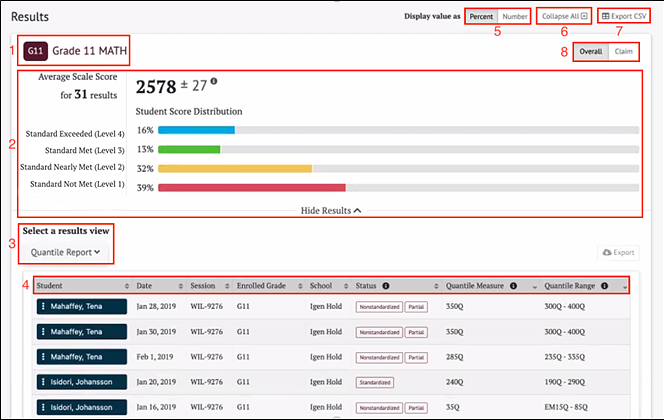
Figure 11. Quantile Report display
The Results page for a Smarter Balanced ICA displays the following information and elements:
- The name and grade of the assessment
- The Group Aggregate Panel displays aggregate data for the selected group of students
- The Select a results view drop-down menu offers the following options for display results:
- [Results by Student] (default view)
- [Results By Item]
- [Key/Distractor Analysis]
- [Quantile Report]
- The Results View table
- The Display value as field contains toggles allowing a user to change the display to show the student score distribution in percentages of students or numbers of students in each reporting category
- The [Collapse All] button, which hides the Results View table for all the displayed assessments and toggles to an [Expand All] button, which displays the results again
- The [Export CSV] button, which gives the option to download the results in CSV format
- Toggle buttons to switch between Performance Scores: [Overall] and [Claim]
- For Overall scores, the [Overall] toggle displays the Student Score Distribution with four achievement levels
- For Claims, the [Claim] toggle displays four claims with three reporting categories
Select a results view for the Quantile Report
Per figure 12 (below), when the Select a results view drop-down is selected, the Select a results view options appears:
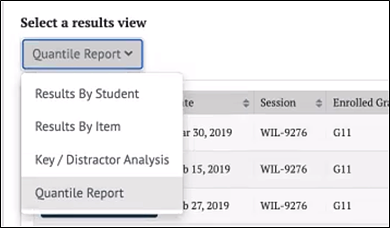
Figure 12. Select a results view for the Quantile Report
The options for each student are:
- [Results by Student] (default view)
- [Results By Item]
- [Key/Distractor Analysis]
- [Quantile Report]
Quantile Measure and Quantile Range
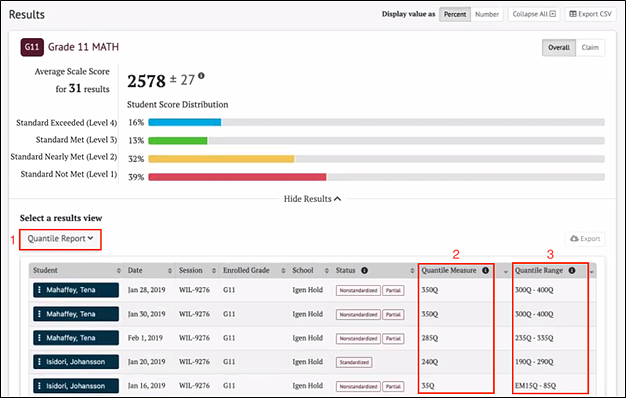
Figure 13. Quantile Measure and Range view
- The Select a results view drop-down menu offers the following options for display results:
- [Results By Student]
- [Results By Item]
- [Key/Distractor Analysis]
- [Quantile Report]
- Quantile Measure: A student’s Quantile measure represents the student’s readiness for mathematics instruction on a scale from below 0Q to above 1600Q.
- Quantile Range. A student’s Quantile range is 50Q above and 50Q below the student’s Quantile measure.
Quantile Measures By Student
The Results By Student table includes the information elements for each student shown below.
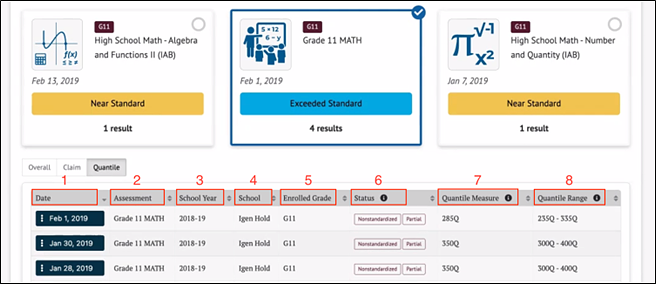
Figure 14. Quantile Measures By Student
The Overall Score table includes the following information for each student:
- Date: Date student completed the assessment
- Assessment: Name of Assessment
- School Year: School year for assessment
- School: Student’s assigned school at the time of the assessment
- Enrolled Grade: Student’s enrolled grade at the time of the assessment
- Status: For interim assessments, assessment status includes whether the assessment administration (Manner of Administration) was Standardized or Nonstandardized, or if the assessment was marked Partial or Complete (Completeness). For summative assessments, assessment status only includes whether the assessment administration (Manner of Administration) was Valid or Invalid. An empty field for a summative assessment indicates a valid assessment status.
- Quantile Measure: A student’s Quantile measure represents the student’s readiness for mathematics instruction on a scale from below 0Q to above 1600Q.
- Quantile Range. A student’s Quantile range is 50Q above and 50Q below the student’s Quantile measure

